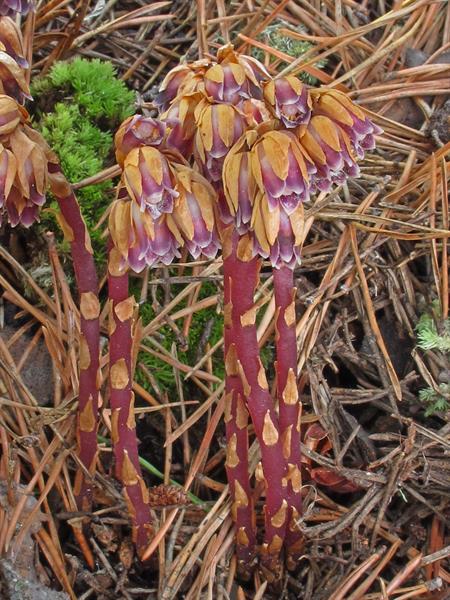
Origin/Endemic status: Endemic
Taxonomy Comments: The ‘fall-flowering form" (entity "lehmaniae", see synonymy), appears to represent the early development of M. odorata which will typically then overwinter in ‘suspended animation’ and flower in the early spring (Klooster, Clark, & Culley 2009; Rose 2012; Rose & Freudenstein 2014).
Other Comments: The flowers are very fragrant, the odor variously compared to cloves, nutmeg, cinnamon, and violets. Since the diminutive plants (3-10 cm tall) are often covered by leaf litter, and the key to finding this species -- for botanists and its primary pollinator, bumblebees -- is the strong fragrance (Klooster, Clark, & Culley 2009). Monotropsis odorata shows fungal host specificity with Hydnellum P. Karst. (Thelephiorales: Bankeraceae)" (Bidartondo & Bruns (2001).
Synonymy: = K3, K4, Tn, Va, Chafin (2000), Rose & Freudenstein (2014), Rose (2012), Weakley (2009a); = n/a – Tat; = Schweinitzia odorata Raf.; > Monotropsis lehmaniae Burnham – S; < Monotropsis odorata Schwein. ex Elliott – C, F, FNA8, G, K1, W, WV, Luteyn et al (1996), Wallace (1975); > Monotropsis odorata Schwein. ex Elliott – S; > Monotropsis odorata Schwein. ex Elliott var. lehmaniae (Burnham) H.E.Ahles – RAB; > Monotropsis odorata Schwein. ex Elliott var. odorata – RAB
Heliophily: 3
Hover over a shape, letter, icon, or arrow on the map for definition or see the legend.
 © Alan M. Cressler | Original Image ⭷
© Alan M. Cressler | Original Image ⭷ © Alan M. Cressler | Original Image ⭷
© Alan M. Cressler | Original Image ⭷ © Alan M. Cressler | Original Image ⭷
© Alan M. Cressler | Original Image ⭷ © Alan M. Cressler | Original Image ⭷
© Alan M. Cressler | Original Image ⭷Feedback
See something wrong or missing on about Monotropsis odorata? Let us know here: (Please include your name and email if at all complicated so we can clarify if needed.)
Cite as...